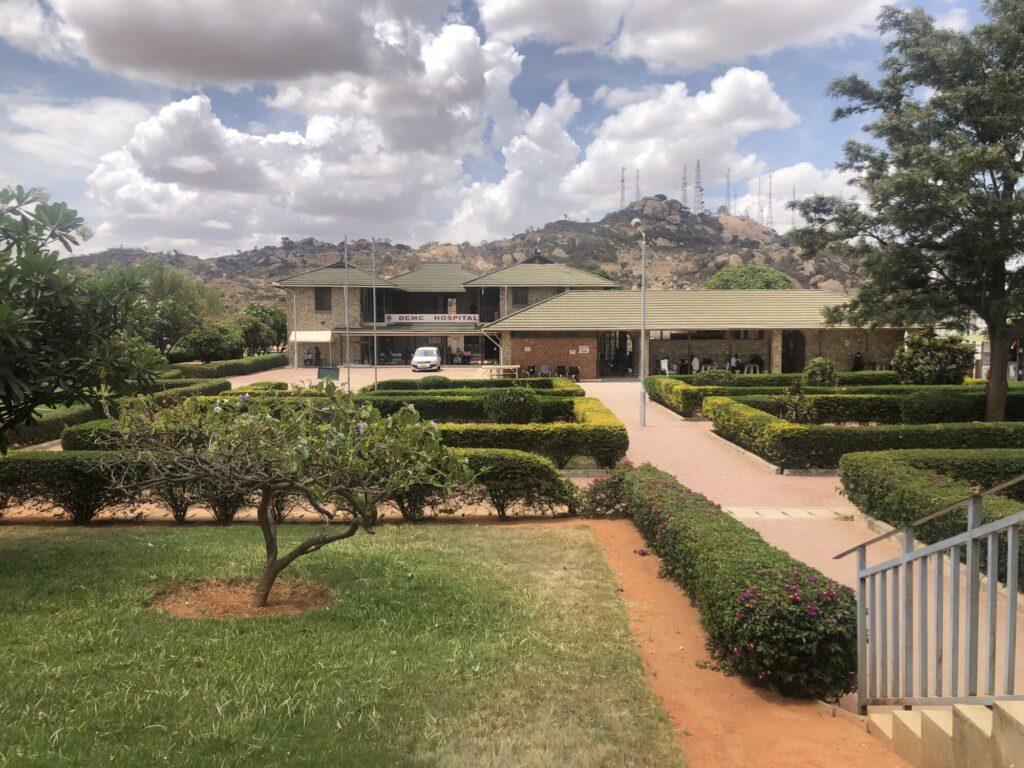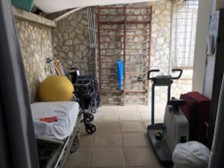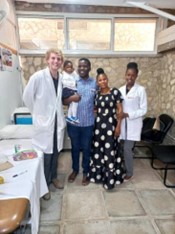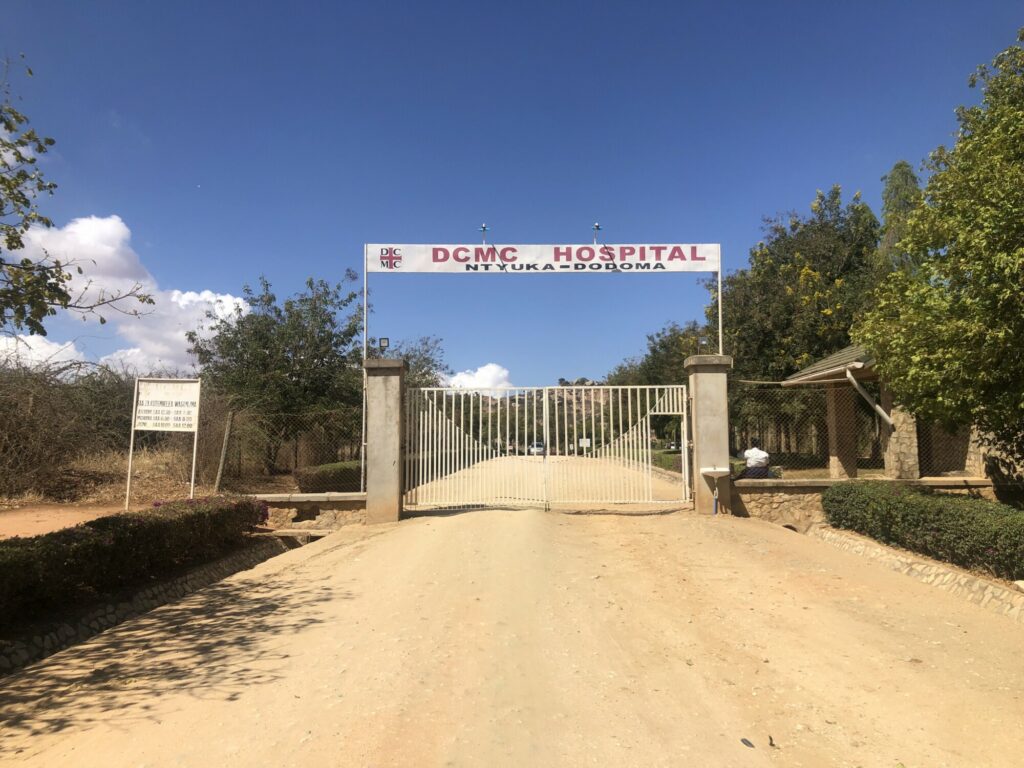Running Before I Could Walk
Table of Contents
International student experiences are increasingly common within health professions including physical therapy.1 Whether students are connecting to their altruistic nature or seeking to fulfill an academic requirement for service learning or clinical education, there are a variety of reasons why one may elect to engage internationally during physical therapy training. Reported benefits of international experiences include improved communication, world view, cultural humility, and desire to work in resource-limited settings after graduation.2 Much of what a student clinical experience will entail outside of the United States will depend on the location of the experience and on program-specific expectations.2 Beyond that, the human factors unique to each exchange and individual cannot be planned.
In this example, we followed an American student who elected to engage in reflection to process a challenging and novel situation in a foreign clinic. As he accounted for cultural factors and attended to the dynamic between the family and the medical center where he worked, he learned to adapt while simultaneously finding his own voice. Yet an evident dichotomy between his own uncertainty and need to be the ‘expert’ remains. This experience, one that pulled together the tangible with the intangible, is one that will live alongside the student as he transitions to his own independent practice. Following is Mitchel Fenrich’s personal account of his clinical rotation in Tanzania.
Arrival—and a Special Case
In early 2022, I arrived in Tanzania as an eager physical therapy student ready to engage in a clinical rotation at the Dodoma Christian Medical Center (DCMC) in Dodoma, Tanzania. Unlike my clinical experiences in the United States I was living in on-site housing and could see DCMC from my temporary home. Each day I walked the path to the physical therapy clinic while soaking in the warm sunshine and fresh air. During this early time in Tanzania, I explored the city of Dodoma, tried new foods, and adjusted to the flow of healthcare.
A few weeks into my 10-week rotation, Nuru, my clinical instructor and a Tanzanian physiotherapist, and I had the opportunity to evaluate and treat an infant we would come to believe was at high risk of having cerebral palsy. As someone with an interest in working with children, and specifically those with disabilities, the subsequent physical therapy management of this child’s case proved to be one of the most impactful parts of my experience in Tanzania. What follows is my honest reflection and recall of this experience through which I confirmed my desire to become a pediatric physical therapist.
Photo 1: Entrance, Dodoma Christian Medical Center

Photo 2: Dodoma Christian Medical Center
Encounter and Evaluation
This story begins when a staff member at DCMC sat across from me at lunch and told me about his daughter, Davina. She was 20 months old and was missing key developmental milestones. After this initial meeting at the cafeteria, I talked with Nuru; a plan was made for the child to be brought into the physiotherapy clinic for an evaluation. Previous notes in the electronic medical record from the pediatrician at DCMC described the infant’s full-term birth as a difficult delivery with mild/moderate birth asphyxia, as well as noting weakness of the right arm and leg. Nuru had seen the child on one occasion at age 14 months, and at that time, our co-worker’s child was scooting on her bottom on the floor to explore her environment, but had not begun standing, walking, or crawling. Nuru also noted right arm hypertonicity and disuse.
Photo 3: Nuru in one half of the physiotherapy clinic

Photo 4: View of the other half of the physiotherapy clinic
Evaluation Session
The evaluation took place a few days after my interaction with the child’s father at DCMC’s cafeteria. At this time, Davina was just a few months shy of her 2nd birthday. During the subjective portion of the evaluation, we learned that her parents were concerned she was still not standing and walking unsupported, not using her right arm/hand, and showing limitations in communication. During the objective piece of the evaluation, our relevant findings included confirmation of hypertonicity of the right arm and leg when compared to the left, no standing or walking without support, no creeping or crawling, and solely using her left hand for reaching tasks. Using pieces of the Hammersmith Infant Neurological Examination,3 Davina’s hand and arm asymmetry were clear. At rest, her right hand was in a near-fist position, while the left hand rested open. The right arm rested in a dystonic position in comparison to the left, and there was increased resistance to passive right shoulder flexion and right forearm pronation/supination when compared to the left. We were also able to complete the gross motor subdomain of the DAYC-2,4 which indicated Davina was in the 6th percentile.
As we synthesized the past medical history, current physical exam, and insights from her parents, we came to believe a high risk of cerebral palsy clinical diagnosis was warranted. Davina displayed motor dysfunction (observable hand and arm asymmetry, low score on DAYC-2,4 disuse of right hand and arm), as well as having a clinical history of a labored birth with associated impairment in oxygen and blood flow to the brain, as reported by the pediatrician. These criteria in combination allow for the clinical diagnosis of high risk of cerebral palsy to be used.5
Perception of Disability in Tanzania
Cerebral palsy is a heavy label. We did not want to be wrong, but this is a very critical time-period for the child—the range of 12 to 24 months. The patient is still at an age where we could maximize neuroplasticity in movement training and try to maximize motor function.
Through conversations with Nuru, I learned that if a child is born in Tanzania with a disability (eg, cerebral palsy), it can be perceived as a punishment for something negative the parents did in the past. Unfortunately, it is common for these children to be kept out of the public eye (eg, the community, school) for this reason, and it can be common for people to hide their diagnosis and to not seek the help they, or their loved one, need.6 In the United States, I had previously spent a significant amount of time at Easterseals Wisconsin Camps, an organization supporting and empowering people with disabilities across the lifespan. This experience allowed me to connect with and befriend many people living with autism, Down Syndrome, cerebral palsy, spina bifida, and other conditions, offering me insight and understanding into people’s lived experiences with disability. It allowed me to realize how powerful and dehumanizing the stigma around disability can be, even in the United States. I frequently heard about people’s experiences of being excluded, misunderstood, teased, and the lack of support, leading individuals to feel isolated, broken, or unwanted.
A Key Point of Cultural Sensitivity
At one point during the evaluation session, I directly used the phrase “cerebral palsy” while talking with Nuru about our findings. I didn’t realize it at the time, but after the evaluation was over, Nuru told me the parents’ expressions changed and their faces fell when I used those words. This prompted a conversation between Nuru and me around views of disability. She recommended communicating the signs, symptoms, and observed clinical presentation when talking with the parents instead of directly using the term. This became even more important when her parents shared that they were being told by others to take Davina to another town to have surgery on the dystonically-positioned right elbow. Nuru and I educated the parents about how we believed the positioning and hypertonicity of the elbow was neurologic in nature, not orthopedic, and that we did not believe that surgery was indicated. This was also a more appropriate approach, as the pediatrician ought to be the one to formally establish a neurological diagnosis such as cerebral palsy.
With all of this in mind, I was incredibly impressed by how open and supportive her parents were. Their support and love for their child was unwavering, and they sought help for her in any ways that they could. They wanted to better understand her condition, her needs, and any potential developmental considerations, as well as to connect her with whatever resources were available. Nonetheless, I did get a firsthand glimpse into the stigma surrounding cerebral palsy and disability in Tanzania.
Treatment Plan
Through conversations with both Davina’s parents, as well as Nuru, we progressed treatment moving toward the following goals: 1) stand independently; 2) walk independently; 3) use the right hand/arm in reaching tasks, as well as other functional activities. Early Intervention for Children Aged 0 to 2 Years with or at High Risk of Cerebral Palsy,7 which is an international clinical practice guideline based on systematic reviews, included the following recommendations:
- Begin intervention at the time of suspected diagnosis to harness neuroplasticity through specific training.
- Implement task-specific motor training with parental coaching to structure practice beyond scheduled therapy sessions (for adequate dosing).
- Implement bimanual and constraint-induced movement therapy as soon as unilateral cerebral palsy is suspected, since the benefits outweigh the risk of harm from unused neuroplasticity windows and false-positive diagnoses.7
Treatment Sessions
Over the next six weeks, Nuru and I worked to apply these recommendations through 6 treatment sessions, both in-clinic and in-home,8 with the hopes of increasing her independence with mobility, access to her environment (namely her home), and participation in meaningful play. Interventions used to work toward our goals included:
- Helping the child into a quadruped position to promote weight bearing through the right hand/arm.
- Encouraging creeping on hands and knees to give the child another option to navigate her environment (in addition to butt scooting).
- Setting up functional tasks to promote bimanual play and reaching with the right hand/arm.
- Setting tasks to promote standing with decreasing levels of support.
- Providing gait training with a four-wheeled walker with a seat.
Education
Education of the parents was critical, as Davina would need to frequently practice targeted skills in her natural environment to maximally influence both brain and body development, and the parents were eager to implement home programming.9,10 This kind of invested family support was not unusual. In fact, I observed families in Tanzania to be much quicker to get involved with the care of their loved ones than families in the United States. I realized the importance of caregiver education because both medical and rehabilitative care is not easily accessible for many in the country, so families were eager to learn to carry out the rehabilitation strategies at home.
For example, when Nuru and I were working with a 71-year-old woman, it would not be uncommon for her daughter, son-in-law, and granddaughter to also be at the appointment. Family members and friends who joined their loved ones were invested, asking questions, getting involved physically, and providing emotional encouragement and support to their family member. In the beginning of the clinical experience, I was intimidated by all these family members and friends watching me, mostly due to my own insecurities as a developing clinician. After a while, I realized this was not about me at all, but about them and their interest and engagement in their loved one’s care.
Motivation and Creativity
Davina displayed significant progress toward all her goals over the 6 treatment sessions. She was very motivated to begin walking, and quickly caught on to using the four-wheeled walker like a gait trainer. Because she really seemed to enjoy the new-found independence in upright exploration, her family had a child-sized walker built for her (Photo 5). Through observations in our treatment sessions and conversations with her parents, Nuru and I also thought Davina would benefit from ankle-foot orthoses (AFOs) for added support with standing and walking. Her parents were able to obtain a set of AFOs at a nearby hospital (Photo 6). She also displayed significantly-improved tolerance to bearing weight through her right hand/arm, and her parents did a great job motivating her to play with toys with both hands (Photos 9, 10).
Results
By the time it was time for me to leave the country, Davina was able to play using both hands, stand independently, and take 3 to 5 steps unsupported and independently. This progress was very exciting to her parents, as well as for Nuru and me. In the months following my clinical experience, I remained in communication with the family and received periodic updates and videos. About 6 months after I left DCMC, I received videos of Davina independently transitioning from the floor to standing, walking around her living room, and kicking a ball.
Photo 5: Davina’s walker

Photo 6: Davina standing with bilateral AFOs donned
Photo 7: Parallel bars at the physiotherapy clinic

Photo 8: Davina her mother, Winnie, and Mitchel during a treatment session
Photo 9: Davina engages in bimanual play during a treatment session

Photo 10: Davina sits unsupported during a treatment session
Reflections on the Sociocultural Aspects of the Clinical Experience
From the moment I landed in Tanzania, I quickly came to realize I didn’t have the option to lean on a group of peers for support. I felt like an outsider in a way I never have in the United States. For the first few weeks, I felt myself acting cautiously, and in a calculated and guarded way that I never have before. I felt a visceral, deep-seated feeling of being unsettled and ungrounded. My sense of belonging had been challenged. This had nothing to do with the people at DCMC, as they were nothing but welcoming and quick to help me feel included and supported. As I settled in, I appreciated being welcomed into the hospital, and experiencing the hospital staff turn from strangers to co-workers to friends. I grew to understand and appreciate the graciousness, trust, and friendships I developed during my time there.
However, the way in which I was treated during my clinical experience caused me to reflect on the way certain aspects of my identity preceded me. More specifically, my identity as a white, American male with blonde hair, blue eyes, and a Midwestern accent seemed to override my identity as a student. This assignment of status somehow meant I must know things, whether I possessed the presumed knowledge or not. Nuru would frequently turn to me and ask for my thoughts and opinions on a patient through the lens of a colleague, vs. a clinical instructor quizzing their student. I would also get asked questions by physicians and nurses in a manner I wasn’t accustomed to during my clinical rotations in the United States.
It was odd to simultaneously feel internal waves of uncertainty, self-doubt, and being overwhelmed as I worked to create my identity as a clinician, while externally being expected to share my thoughts and opinions at a level I felt I hadn’t yet earned. It felt, at times, like my opinion was valued more because I was a white, American male than based on the knowledge I possessed or the merits I carried. Because I was coming from America, I felt an unspoken expectation to bring new knowledge or a better way of doing things. This position of status/power was not one I sought out, but one I was granted and that preceded me. The power dynamics with respect to certain aspects of identity: male/female, white/black, American/Tanzanian, and student/professional were constantly on my mind. I was aware of the historical context of the white “savior” role in Africa and did not want to come across this way.
Taking Responsibility
This experience required me to take ownership and responsibility for my thoughts and actions. It also encouraged me to remain aware of the power dynamics around me, and to be constantly assessing and understanding my place in them. In times where I didn’t know the answer, I would fall back on the current evidence and the ‘first, do no harm’ mindset.
One part of the clinical experience at DCMC I really enjoyed was my relationship with Nuru, my clinical instructor. Nuru let me do a lot of hands-on work, while she did a lot of the communicating with and interpreting between me and patients—as a majority spoke Swahili, and I did not speak the language. I also needed a lot of guidance adapting to cultural norms that were unfamiliar to me. Both Nuru and other Tanzanians were very gracious when I made mistakes, understanding there was no ill intent behind them. When working with a patient, if I sensed surprise or confusion among the patient or their families, I learned to seek clarification and ameliorate confusion or distress. By paying attention to social cues and maintaining a posture of humility, I learned I could adapt and quickly correct culturally-insensitive behaviors.
Insights for Future Practice
I believe I will be able to translate this experience to my future clinical practice. When working with minority and marginalized populations, I will have a better appreciation of what it feels like to have a shaken sense of belonging, and the challenges of participating in a system that one doesn’t fully understand nor feel included within. I will also bring my understanding of the unearned status of authority that accompanies my identity as a white male in a clinical setting.
Final Thoughts
Leaving Tanzania, and specifically DCMC, was extremely bittersweet. On the one hand, I was excited to return home to see family and friends, and to be one step closer to graduating physical therapy school. On the other hand, I didn’t want to leave the people with whom I had developed relationships over the past several months. As someone who is very relationship-driven, the thought of being able to interact with my newfound Tanzanian friends one day, only to be 8,000+ miles away from them the next day, was difficult. I soothed my sense of loss with a deep self- assurance that I would return someday. This would not be the last time I intended to see my friends in Dodoma. I shared many goodbyes, and frequently settled on the departure as a ‘see you later’, to both the people and the country.
The success and meaningfulness of my clinical experience wouldn’t have been possible without the support and kindness from a multitude of people: to Nuru, for helping me feel settled, supported, and taken care of as a human, while also guiding and empowering me as a clinician; to Winnie and Dickson, Davina’s parents, for trusting me and allowing me to have my first hands-on experience working with a child through the lens of a physical therapy clinician (in training); to the entire DCMC staff, for allowing me to integrate myself into their hospital team and going out of their way to make sure I felt welcome. Thank you, Tanzania, for the richness you provided in such a short period of time.
Photo 11: Mitchel Fenrich, SPT and Nuru Mohamed, PT

Photo 12: Davina, her parents, Dickson and Winnie, Nuru, and Mitchel
References
- Pechak CM, Black JD. Proposed guidelines for international clinical education in US-based physical therapist education programs: results of a focus group and Delphi Study. Phys Ther. 2014;94(4):523-533.
- Hartman J, Magnusson D. International experiences in physical therapist education: a descriptive study. J Phys Ther Educ. 2021;35(1):75-82.
- Maitre NL, Chorna O, Romeo DM, Guzzetta A. Implementation of the Hammersmith Infant Neurological Examination in a High-Risk Infant Follow-Up Program. Pediatr Neurol. 2016;65:31-38.
- Voress JK, Maddox T. Developmental Assessment of Young Children – Second Edition: DAYC-2. Austin, TX: Pro-ed.; 2014.
- Novak I, Morgan C, Adde L, et al. Early, accurate diagnosis and early intervention in cerebral palsy. JAMA Pediatr. 2017;171(9):897.
- Zuurmond M, Seeley J, Nyant GG, et al. Exploring caregiver experiences of stigma in Ghana: they insult me because of my child. Disabil Soc. 2022;37(5):827-848.
- Morgan C, Fetters L, Adde L, et al. Early intervention for children aged 0 to 2 years with or at high risk of cerebral palsy. JAMA Pediatr. 2021;175(8):846-858.
- Gannotti ME, Christy JB, Heathcock JC, Kolobe THA. A Path Model for evaluating dosing parameters for children with cerebral palsy. Phys Ther. 2014;94(3):411-
- Kolb B, Muhammad Harnessing the power of neuroplasticity for intervention. Frontiers Hum Neurosci. 2014;8:377.
- Nithianantharajah J, Hannan AJ. Enriched environments, experience-dependent plasticity and disorders of the nervous system. Nat Rev Neurosci. 2006;7(9):697-709.
About the Author(s)

Mitchel Fenrich, PT, DPT
Mitchel Fenrich is a pediatric-based physical therapist where he primarily works with children with autism. He is a 2022 graduate of the University of Minnesota Physical Therapy Program where he now regularly serves as a lab assistant in the Pediatric course series. He holds a Bachelor of Science degree and a certificate in Global Health from the University of Wisconsin. During his physical therapy training, Mitchel spent time working with a local clinician in Dodoma, Tanzania. In his spare time Mitchel enjoys spending time with family and in the outdoors.

Corri Stuyvenberg, PT, DPT, MA
Corri Stuyvenberg is a Board-Certified Clinical Specialist in Pediatric Physical Therapy with over 25 years as an early intervention, multi-disciplinary team member. She completed her Certificate in Infant and Early Childhood Mental Health and has received her Endorsement® in Infant Mental Health. She is an Assistant Professor in the Division Physical Therapy at the University of Minnesota Medical School, primarily instructing pediatric physical therapy coursework. Corri is also a PhD Candidate in Rehabilitation Science at the University of Minnesota. Her research explores associations between qualities of parent-infant relationships and infant motor development in both term and pre-term infants.

Amanda Sharp, PT, DPT, PhD
Dr. Sharp is the Associate Program Director, Director of Student Affairs, and an Associate Professor in the Division of Physical Therapy at the University of Minnesota. There, she directs a series of courses related to professional development with an emphasis on historical and contemporary issues related to practice. She emphasizes self-awareness, reflection, and advocacy, striving to ensure students consider the complex role of clinical practice, seeing beyond a diagnosis or treatment plan to truly engage with their clients. Dr. Sharp is an educational researcher with a PhD in Higher Education from the University of Minnesota. Her research centers on disability diversity in physical therapy education and she is a regular consultant to students, colleagues, and other professionals on ways to support disability diverse learners in healthcare education. She further retains an active role as a research collaborator with a team focused on the long-term development of clinical educators.
![]()
This work is licensed under a Creative Commons Attribution 4.0 International License.







